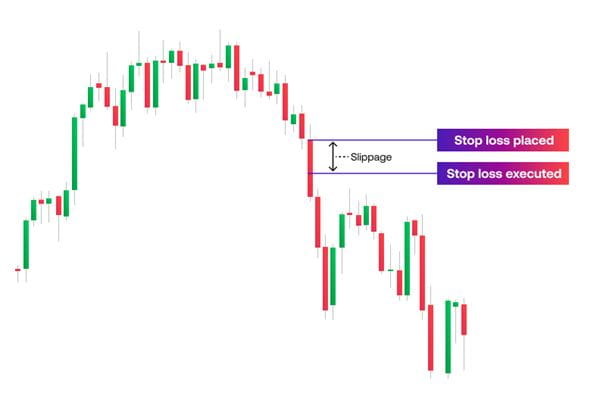
What is price slippage?
Price slippage is the term that describes instances when traders have to settle for a different price than what they initially requested due to the underlying market changing in value quickly.
It’s important to understand slippage because it can impact your trading costs, alongside other fees.
Slippage occurs when there is either low liquidity in a market – meaning there are fewer participants to take another side of a trade causing delays – or high volatility, causing prices to change rapidly.
Typically, when you place a buy or sell order with your broker, you expect it to be filled at your chosen price. But when a market is experiencing slippage, the bid/ask spread changes between the time your broker submits the order and when an exchange or market maker executes it, resulting in a different price.

Slippage tends to occur more frequently around large market-moving events – such as central bank announcements – or when earnings are released outside of trading hours, which can cause the market to change price overnight and potentially gap upon opening.
Slippage in forex
Although slippage can occur in all financial markets, it’s more common in forex as currency prices are prone to higher levels of volatility. However, slippage is less common in major currency pairs, such as EUR/GBP, GBP/USD and USD/JPY, given that they have extremely high liquidity.
How does slippage work?
Slippage can either work for or against your position because there are two types: negative and positive slippage.
Negative slippage is the name for when the price difference gives you a worse rate than intended. For example, if the price is higher than the expected price for a long position, or lower than the expected price for a short position.
Positive slippage is the name for an advantageous price difference. For example, if the price is lower than expected for a long position, or higher than expected for a short position.
How to avoid slippage in trading
Slippage is a normal part of trading, so it’s not completely avoidable. But there are a few ways you can minimise your risk of slippage in trading. For example, you could avoid large market-moving events, opt to trade on lower volatility markets or those with higher liquidity.
But given that this reduces the opportunities available to traders, the most common way of avoiding slippage in trading is by applying guaranteed stop-loss orders (GSLOs) and limit orders to positions.
Guaranteed stop-loss orders
A guaranteed stop loss is an order that closes your trade at the exact level chosen by you, regardless of price slippage. A regular stop loss may incur slippage in times of heightened volatility but with a guaranteed stop, we take on the risk of slippage for you.
GSLOs are free to attach, but you will be charged a premium if your order is triggered. You can attach and amend your GSLOs within our market hours for free, but minimum distances do apply and are shown in the deal ticket for each market.
Learn about orders and positions
Limit orders
Limit orders are instructions to execute a position at a price that is more favourable than the current market price. So, your order will be filled at the specified price or better, meaning slippage doesn’t apply.
For a sell (short) order this would be at the desired price or a higher price, whereas for a buy (long) it would be at the specified price or a lower price.
If the order cannot be executed under these terms, it will likely be rejected. However, it’s important to check how your specific broker treats limit orders before trading.
What is slippage tolerance?
Slippage tolerance is a setting in trading platforms that allows you to determine how much price slippage you’re willing to accept so that your order can be executed.
If the market does slip, and you haven’t set a price tolerance, your broker will just accept the next available market price. But setting a price tolerance means that you can limit this difference, giving you more control over your risk.
With City Index, you can amend your price tolerance level in the market information section for each asset. And if you want to remove the tolerance completely, you can set it to zero. But if the execution price moves, your order will fail, and you’ll have to submit a new request.





